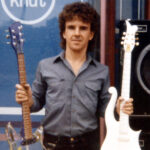The guitar. It’s more than just an instrument; it’s a voice, an extension of the soul for countless musicians. Joan Jett famously declared, “My guitar is not a thing, it is an extension of myself. It is who I am.” This sentiment resonates with guitarists and fans alike, highlighting the instrument’s primal, expressive nature. From humble beginnings to virtuosic heights, the guitar’s journey is as diverse and captivating as the players who wield it. Exploring what truly defines a “great” guitarist is a fascinating endeavor, and in the realm of rock music, the criteria are as varied as the genre itself.
Inspired by Rolling Stone‘s extensive list of guitarists, we at guitarplayers.net have delved deep to celebrate the Great Rock Guitar Players who have shaped music history. While their list spanned 250 artists across genres, we’re focusing specifically on rock and its diverse subgenres, aiming to provide a richer, more guitar-centric perspective for our audience of passionate players and enthusiasts.
Rock guitarists are often as iconic as the frontmen they share the stage with. Names like Jimmy Page, Brian May, and Eddie Van Halen instantly conjure images of legendary performances and groundbreaking sounds. But the story of rock guitar is far broader than just these mythic figures. It’s a constantly evolving tapestry woven from diverse threads of innovation, influence, and raw talent.
Our exploration spans generations, from pioneers who laid the foundation to modern innovators pushing boundaries. We celebrate not only the virtuosos with breathtaking technical skill, but also the players who prioritized feel over flash, invention over polish, and songwriting prowess over mere instrumental proficiency. We value the risk-takers, the originators, and those who channeled their unique gifts into creating timeless songs and game-changing albums.
As modern blues visionary Gary Clark Jr. wisely stated, “I don’t know if I want to get too far off the path — I don’t want to get lost in the forest — but I like to wander out a bit and adventure.” This spirit of adventure, of pushing boundaries while staying true to the heart of rock, is what defines the greatest rock guitar players.
Let’s dive into a selection of these incredible artists, exploring their unique styles, key contributions, and the sounds that cemented their place in rock history.
Andy Summers
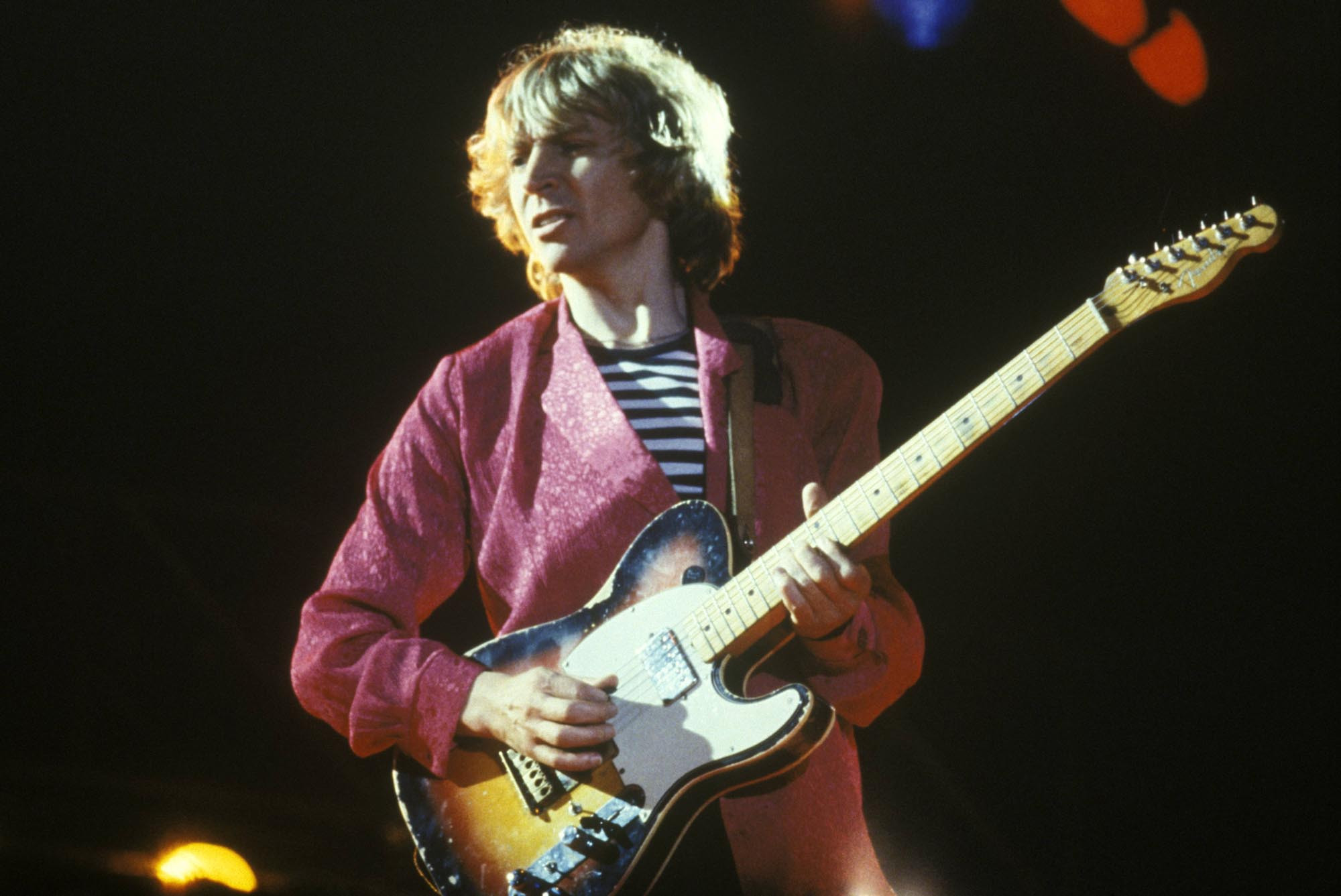 Andy Summers of The Police playing a Fender Telecaster guitar live onstage at Hammersmith Odeon, London, UK (Photo by Graham Wiltshire/Redferns)
Andy Summers of The Police playing a Fender Telecaster guitar live onstage at Hammersmith Odeon, London, UK (Photo by Graham Wiltshire/Redferns)
Image Credit: Graham Wiltshire/Redferns/Getty Images
Andy Summers was the sonic architect behind The Police, a band that redefined the power trio for a new wave era. Moving swiftly beyond punk’s raw simplicity, Summers masterfully blended jazz chord voicings and reggae rhythms into a distinct rock sound. His playing was characterized by its sparseness and precision, creating clipped, twitchy textures or dub-inspired washes of sound, leaving ample space for Sting’s vocals and Stewart Copeland’s drumming. This economical approach was incredibly effective, allowing each instrument to breathe and contribute to the band’s signature sound.
Summers’ guitar work was not about flashy solos, but about crafting the perfect sonic landscape for each song. His tone, often achieved with a Fender Telecaster, was clean yet edgy, capable of both shimmering beauty and sharp attack. His ability to seamlessly transition between genres, incorporating jazz sophistication and reggae groove into a rock context, was truly groundbreaking. Alex Lifeson of Rush aptly described Summers’ style: “His tone and style were just absolutely perfect — he left space around everything. And he can handle anything from beautiful acoustic playing to jazz to hybrid kinds of stuff.”
Key Tracks: “Message in a Bottle,” “Every Breath You Take”
Brittany Howard
 Brittany Howard of Alabama Shakes playing guitar, soulful vocals and raw energy, captured in a close-up portrait. (Image Credit: Sacha Lecca for Rolling Stone)
Brittany Howard of Alabama Shakes playing guitar, soulful vocals and raw energy, captured in a close-up portrait. (Image Credit: Sacha Lecca for Rolling Stone)
Image Credit: Sacha Lecca for Rolling Stone
Brittany Howard’s guitar playing is as integral to her musical identity as her powerhouse vocals and soulful songwriting. From her beginnings with the garage-roots band Alabama Shakes, Howard’s guitar work has been earthy, fluid, and admirably raw. It’s a style born from feel and instinct, perfectly complementing her vocal delivery. Her rhythmic sensibilities are elastic and dynamic, evident in the way her jagged guitar lines intertwine with Heath Fogg’s lead guitar in Alabama Shakes tracks like “Don’t Wanna Fight.”
Beyond Alabama Shakes, Howard has explored different facets of rock guitar. Her side project, Thunderbitch, allowed her to dive into straight-ahead, high-energy rock and roll. Her critically acclaimed solo album, Jaime, further showcased her open-ended musicianship, ranging from the funky, James Brown-esque rhythms of “History Repeats” to the thick, molten fuzz of “Presence.” Howard’s versatility stems from her ability to channel raw emotion through her guitar, whether it’s gritty blues-rock or experimental sonic textures. Her guitar is an extension of her voice, adding layers of depth and intensity to her already powerful musical presence.
Key Tracks: “History Repeats,” “Presence”
Robby Krieger
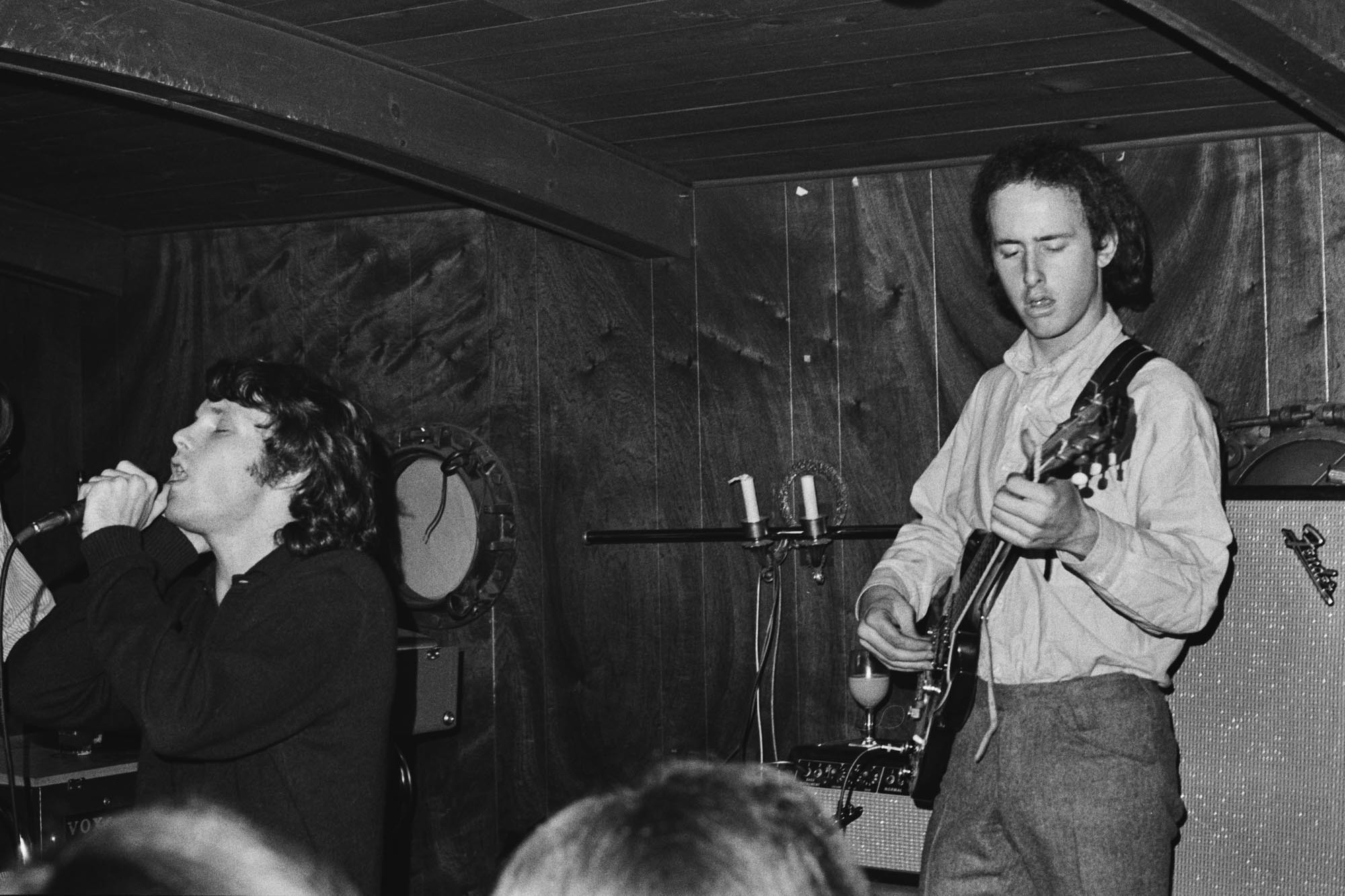 Robby Krieger of The Doors performing with Jim Morrison and Ray Manzarek in 1966, showcasing his unique guitar style. (Photo by Don Paulsen/Michael Ochs Archives/Getty Images)
Robby Krieger of The Doors performing with Jim Morrison and Ray Manzarek in 1966, showcasing his unique guitar style. (Photo by Don Paulsen/Michael Ochs Archives/Getty Images)
Image Credit: Don Paulsen/Michael Ochs Archives/Getty Images
Robby Krieger, the guitarist for The Doors, was a true innovator, pushing beyond the blues-centric confines of rock guitar in the late 1960s. His background in flamenco and jazz provided him with a unique improvisational approach, perfectly suited to follow Jim Morrison’s unpredictable and theatrical stage presence. While Morrison was the shamanic frontman, Krieger was the musical navigator, crafting guitar lines that were both melodic and exploratory. He was also a key songwriter for the band, penning hits like “Light My Fire.”
The Doors’ unconventional lineup, lacking a bass player, forced Krieger to adapt and expand his role. He filled the sonic space by incorporating bass lines and rhythmic textures into his guitar playing, creating a fuller, more orchestral sound. “Not having a bass player … made me play more bass notes to fill out the bottom,” he explained. “Not having a rhythm player also made me play differently, to fill out the sound. I always felt like three players simultaneously.” This unique approach, combined with his jazz-influenced phrasing and flamenco flourishes, made Krieger’s guitar work instantly recognizable and a crucial part of The Doors’ mystique.
Key Tracks: “Riders on the Storm,” “Roadhouse Blues”
Ricky Wilson
 Ricky Wilson of The B-52s performing live in Athens, Georgia in 1978, known for his unconventional guitar style. (Photo by Tom Hill/WireImage)
Ricky Wilson of The B-52s performing live in Athens, Georgia in 1978, known for his unconventional guitar style. (Photo by Tom Hill/WireImage)
Image Credit: Tom Hill/WireImage
Ricky Wilson, the enigmatic guitarist for The B-52s, often seemed content to remain in the background amidst the band’s flamboyant stage presence. However, his quirky and inventive guitar style was essential to the band’s unique New Wave sound. Wilson’s playing was a distinctive blend of downhome chicken scratch, angular post-punk rhythms, rockabilly twang, and surf rock reverb. On classics like “52 Girls,” “Strobe Light,” and “Private Idaho,” his guitar lines were as unconventional and memorable as the band itself.
Wilson’s approach to the guitar was deliberately unconventional. He often used only four or five strings on his blue Mosrite guitar and experimented with odd tunings to achieve a strange, spartan sound. “I just tune the strings till I hear something I like,” he once said, reflecting his intuitive and experimental nature. This minimalist approach, combined with his eclectic influences, made him a truly unique and influential guitarist of the New Wave era. His untimely death in 1985 was a significant loss to the indie-rock scene, depriving the world of a truly original musical voice.
Key Tracks: “52 Girls,” “Mesopotamia”
Leslie West
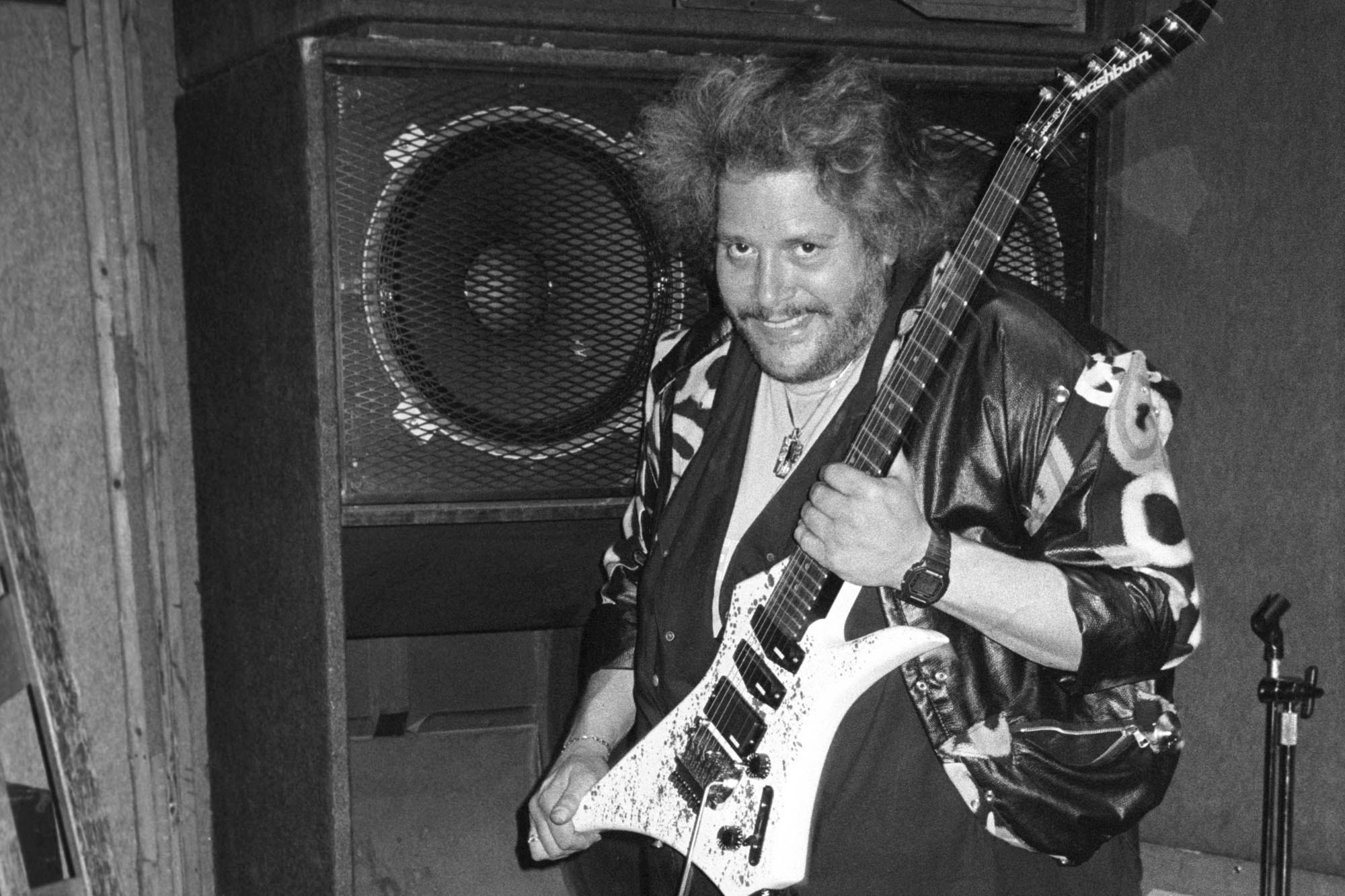 Leslie West of Mountain performing live in the 1970s, known for his powerful riffs and blues-rock sound. (Photo by Erica Echenberg/Redferns)
Leslie West of Mountain performing live in the 1970s, known for his powerful riffs and blues-rock sound. (Photo by Erica Echenberg/Redferns)
Image Credit: Erica Echenberg/Redferns/Getty Images
Leslie West, born Leslie Weinstein, made his mark with a powerful, blues-infused guitar style that became synonymous with the band Mountain. He first gained attention in the mid-Sixties garage rock scene with The Vagrants’ cover of Otis Redding’s “Respect,” showcasing his meaty guitar tone. By 1969, he had formed Mountain, a band that channeled the heavy power of Cream into a distinctly American context.
West’s signature sound was characterized by roughened blues lines played with deceptive ease and an R&B sensibility, all delivered through a wall of cranked-up, distorted amplifier tone. His 1970 hit, “Mississippi Queen,” is a perfect example of his style: a simple yet incredibly powerful riff driven by massive guitar tone. Dave Davies of The Kinks recognized West’s unique blend of power and feel: “The riffs were incredible. He could play flashy, intricate phrases. But he wasn’t a look-at-me guy. He played with feel.” West’s legacy is one of raw power and blues-rock authenticity, influencing generations of hard rock and metal guitarists.
Key Tracks: “Mississippi Queen,” “Nantucket Sleighride (To Owen Coffin)”
Steve Jones
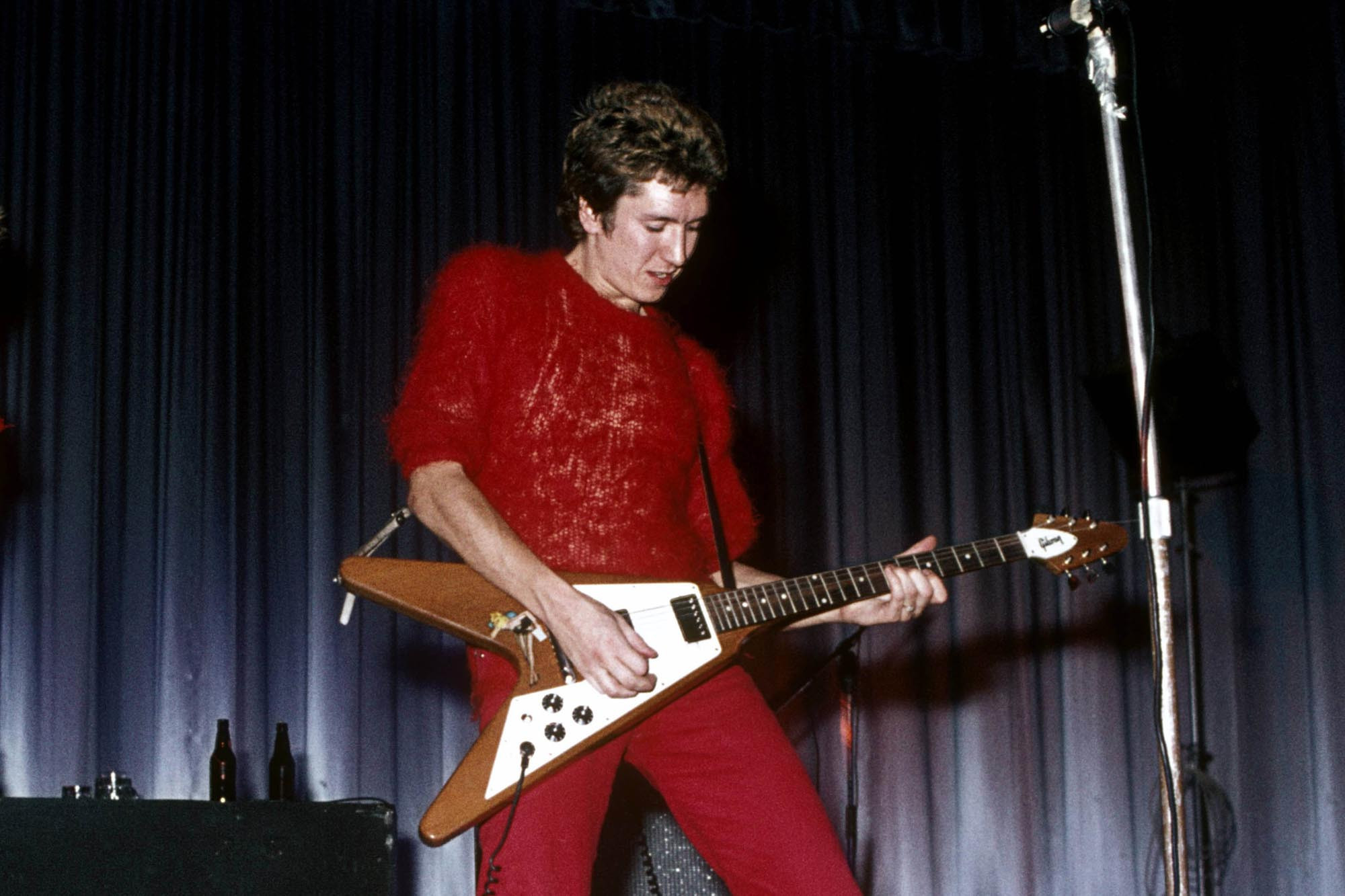 Steve Jones of the Sex Pistols playing a Gibson Les Paul guitar live onstage at Dunstable, UK. (Photo by Chris Morphet/Redferns/Getty Images)
Steve Jones of the Sex Pistols playing a Gibson Les Paul guitar live onstage at Dunstable, UK. (Photo by Chris Morphet/Redferns/Getty Images)
Image Credit: Chris Morphet/Redferns/Getty Images
Steve Jones, the guitarist for the Sex Pistols, embodied the raw, rebellious spirit of punk rock. Given a white Les Paul Custom (or similar) by Sex Pistols manager Malcolm McLaren, Jones wielded the instrument as a weapon of sonic disruption. His style was built on brutish power chords and flamboyant, gutter-glam inspired solos, a perfect sonic mirror for Johnny Rotten’s snarling vocals and provocative lyrics.
Jones’ guitar playing was more about attitude and impact than technical virtuosity. He created indelible riffs on the Sex Pistols’ seminal album, Never Mind the Bollocks, Here’s the Sex Pistols, which became a blueprint for countless punk rock and hard rock guitarists. From Slash to Billie Joe Armstrong, musicians were inspired by Jones’ raw power and unapologetic approach. His legacy is not just about the notes he played, but the attitude he projected. As Jones himself famously declared, “Actually, we’re not into music. We’re into chaos.” This chaotic energy, channeled through his guitar, became a defining sound of punk rock.
Key Tracks: “God Save the Queen,” “Pretty Vacant”
Glenn Tipton and K.K. Downing
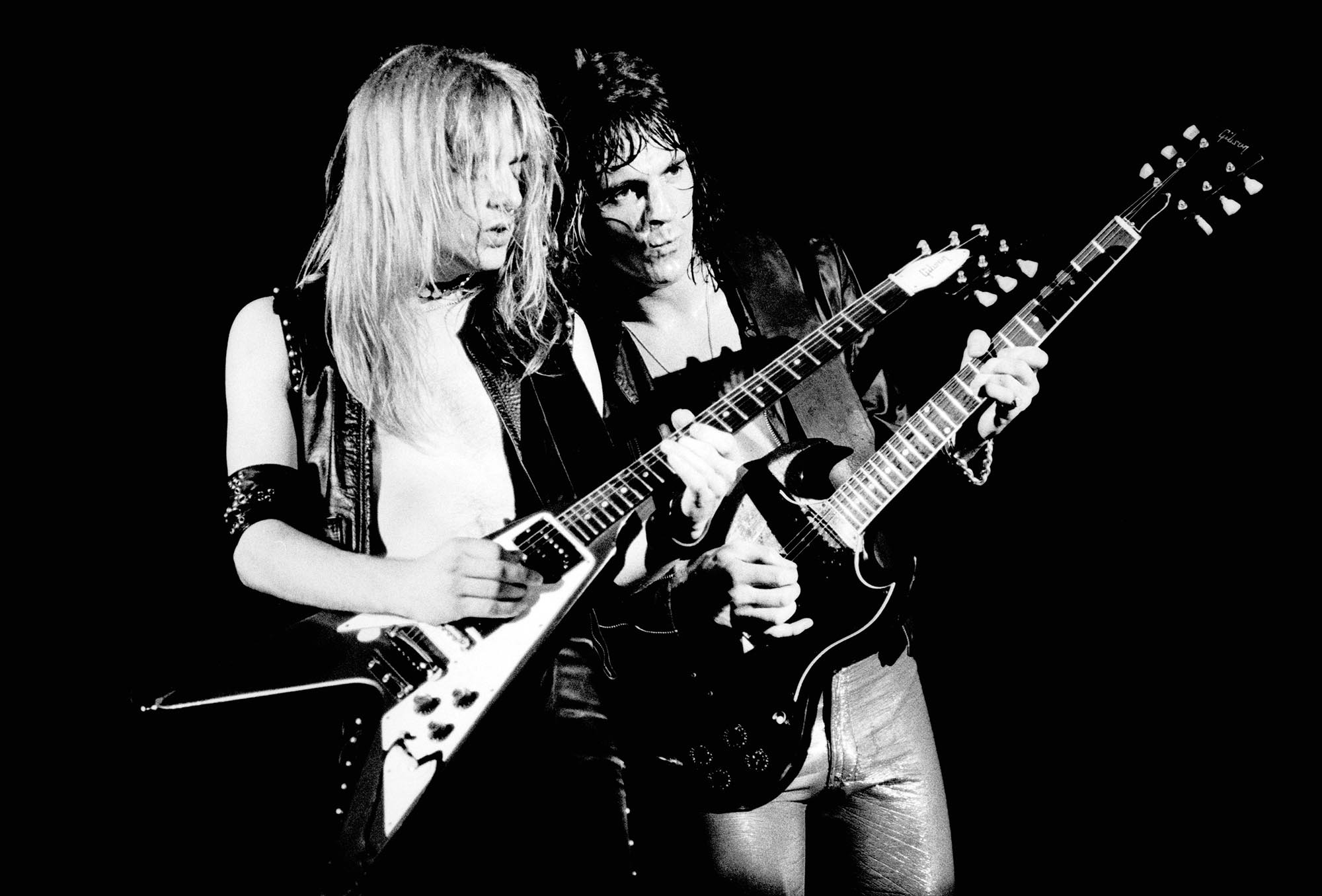 Glenn Tipton and K.K. Downing of Judas Priest performing live in London, circa 1978, pioneering the dual guitar attack in heavy metal. (Photo by Gus Stewart/Redferns/Getty Images)
Glenn Tipton and K.K. Downing of Judas Priest performing live in London, circa 1978, pioneering the dual guitar attack in heavy metal. (Photo by Gus Stewart/Redferns/Getty Images)
Image Credit: Gus Stewart/Redferns/Getty Images
Judas Priest revolutionized heavy metal guitar playing with the dual guitar attack of Glenn Tipton and K.K. Downing. Inspired by bands like Black Sabbath and Led Zeppelin, but seeking to amplify the heaviness, Tipton and Downing pioneered a style that moved beyond the single guitarist format. Rather than simply dividing rhythm and lead duties, they doubled riffs, traded blistering solos, and incorporated harmonized leads into Judas Priest’s signature motorcycle-revving sound.
Their interplay and musical partnership became a template for countless two-guitar bands that followed, including Iron Maiden, Metallica, and Slayer. The contrasting styles of Tipton and Downing created a dynamic and powerful sonic landscape. As Kerry King of Slayer noted, “You can almost always tell that if it’s Tipton, it’s super-fucking tasty. If it’s K.K., it’s a more edgy, almost punky kind of vibe, which is a great mix.” This “great mix” of melodic precision and raw edge became a cornerstone of heavy metal guitar playing, influencing generations of musicians and shaping the genre’s sound.
Key Tracks: “Victim of Changes,” “Breaking the Law,” “The Hellion/Electric Eye”
Lzzy Hale
 Lzzy Hale of Halestorm performing live, a modern icon of hard rock guitar and vocals. (Image Credit: Tim Mosenfelder/Getty Images)
Lzzy Hale of Halestorm performing live, a modern icon of hard rock guitar and vocals. (Image Credit: Tim Mosenfelder/Getty Images)
Image Credit: Tim Mosenfelder/Getty Images
Lzzy Hale is a modern force in hard rock, not only for her powerhouse vocals but also for her fierce and dynamic guitar playing. As the frontwoman and guitarist for Halestorm, Hale has carved a place as a leading female figure in contemporary rock guitar. Her playing style is aggressively rhythmic, complementing Halestorm’s lead guitarist Joe Hottinger, while also showcasing her own shredding capabilities. A prime example is how she mimics the vocal melody of “I Miss the Misery” on her guitar, demonstrating her instrumental prowess.
Hale’s influence on 21st-century guitar rock is undeniable. Gibson Guitars recognized her impact by making her their first female brand ambassador, even designing a Lzzy Hale signature Explorer model. She proudly plays this model onstage and gifts it to fellow musicians, highlighting her commitment to empowering other female guitarists. As Hale herself stated, “The people at Gibson keep telling me the demographic that buys the most electric guitars right now are female. The wave is coming whether anybody likes it or not.” Lzzy Hale is at the forefront of this wave, inspiring a new generation of rock guitarists.
Key Tracks: “I Miss the Misery,” “The Steeple”
Kurt Vile
 Kurt Vile in a studio in Amsterdam, holding a Fender Jaguar guitar, known for his laid-back yet virtuosic guitar style. (Photo by Paul Bergen/Redferns)
Kurt Vile in a studio in Amsterdam, holding a Fender Jaguar guitar, known for his laid-back yet virtuosic guitar style. (Photo by Paul Bergen/Redferns)
Image Credit: Paul Bergen/Redferns/Getty Images
Kurt Vile projects an easy-going, slacker persona, but beneath the surface lies a serious and subtly virtuosic guitarist. His style is a unique blend of chilled-out drones and intricate, melodic solos, influenced in part by his early experiences playing the banjo. He received a banjo as a teenager after initially asking for a guitar, and the instrument’s open tuning and drone string profoundly shaped his approach to the guitar.
“Banjos are in an open tuning, and they’ve got that high drone string,” Vile explained. “It’s not like you’d even think about that when you’re playing as a kid, but I came to really like that ethereal drone.” This “ethereal drone” became a key element of his guitar sound, combined with influences from across the musical spectrum. Vile’s guitar playing is characterized by its relaxed yet intricate nature, creating a bed-headed style that is both gently captivating and subtly virtuosic. His collaborations, including Lotta Sea Lice with Courtney Barnett, further highlight his guitar chemistry and improvisational skills.
Key Tracks: “Pretty Pimpin,” “Wakin on a Pretty Day”
Gary Clark Jr.
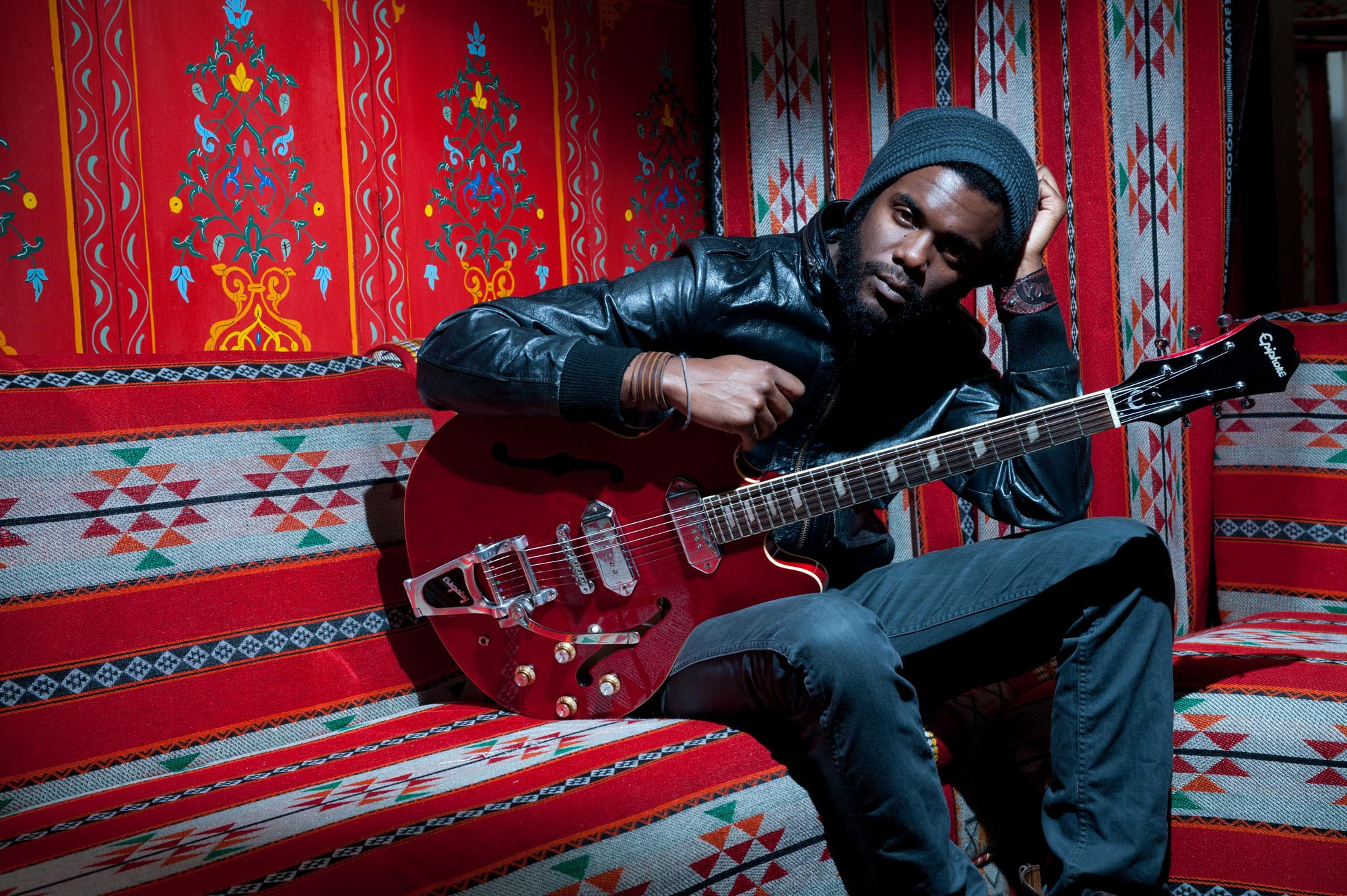 Gary Clark Jr. portrait, showcasing his blues-rock guitar style and soulful vocals. (Image Credit: Rob Monk/Guitarist Magazine/Future/Getty Images)
Gary Clark Jr. portrait, showcasing his blues-rock guitar style and soulful vocals. (Image Credit: Rob Monk/Guitarist Magazine/Future/Getty Images)
Image Credit: Rob Monk/Guitarist Magazine/Future/Getty Images
Gary Clark Jr. initially faced comparisons to guitar icons like Jimi Hendrix and Stevie Ray Vaughan, but he has consistently proven to be a much broader and more versatile guitarist. While rooted in blues-rock, Clark Jr.’s playing incorporates elements of soul, funk, grunge, and even hip-hop, creating a sound that is both familiar and distinctly his own. His collaborations with artists as diverse as Foo Fighters, Alicia Keys, and Tech N9ne demonstrate his genre-bending approach.
Clark Jr.’s guitar playing is fiery and expressive, capable of both blistering solos and soulful, nuanced textures. He is not content to simply replicate the blues-rock of the past, but actively pushes the genre forward, incorporating contemporary influences and sonic experimentation. “I don’t think that I’m reaching my full potential if I just do what people expect of me,” he told Rolling Stone. “I love to play, and I love to experiment, and there are a lot more roads to explore. I don’t know if I want to get too far off the path — I don’t want to get lost in the forest — but I like to wander out a bit and adventure.” This adventurous spirit is what makes Gary Clark Jr. a vital and exciting voice in modern rock guitar.
Key Tracks: “This Land,” “Grinder”
Conclusion
This exploration offers just a glimpse into the vast and diverse world of great rock guitar players. From the innovative jazz-rock fusion of Andy Summers to the raw punk energy of Steve Jones, and the modern dynamism of Lzzy Hale to the genre-bending explorations of Gary Clark Jr., these artists represent the breadth and depth of rock guitar. They are innovators, icons, and inspirations, each contributing their unique voice to the ongoing evolution of rock music.
The criteria for “greatness” in rock guitar are subjective and multifaceted. Technical skill is certainly a factor, but it’s often the less tangible qualities – feel, innovation, songwriting contribution, and sheer impact – that truly elevate a guitarist to legendary status. These players have not only mastered their instrument but have also used it to shape the sound of rock, inspire generations of musicians, and move audiences worldwide.
Explore these artists further, listen to their key tracks, and delve into their discographies. You’ll discover not just great guitar playing, but the heart and soul of rock music itself. And for more deep dives into the world of guitar, keep exploring guitarplayers.net!

